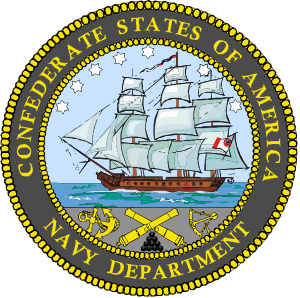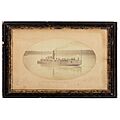List of ships of the Confederate States Navy facts for kids
This is a list of ships used by the Confederate States of America (CSA) during the American Civil War from 1861 to 1865. It includes warships, support ships, and even some civilian boats that helped the Confederate Navy. You'll find different types of ships here, like blockade runners (ships that tried to get past enemy blockades), steamboats, and privateers (private ships allowed to attack enemy ships). We'll also look at special floating batteries and harbor defense boats.
Contents
The leader of the Confederate Navy, Stephen Mallory, worked hard with a small budget. He had a plan to build strong ironclad warships for defending the coast and to use fast cruisers for attacking enemy trade ships. He also explored new weapons like torpedo boats.
Ironclad Ships
Ironclad ships were a big deal after the Battle of Kinburn. Countries like Britain and France started building warships with heavy armor. In 1861, the Confederate Navy needed quick defenses. They couldn't afford the huge, new ocean-going ironclads like the French Gloire or the British Warrior.
So, in May 1861, the Confederate Congress approved $2 million to buy ironclads from other countries. They also started building and changing wooden ships into ironclads at home. On October 12, 1861, the Manassas became the first ironclad to fight in a battle on the Mississippi River. In February 1862, the even bigger Virginia joined the Navy. It was built in Norfolk. The Confederacy built many ships like the Virginia, and several saw action. For example, the Palmetto State and Chicora helped defend Charleston in April 1863. Later, at the Mobile Bay, the Union Navy faced the powerful Tennessee.
Steam-Powered Ironclads
These ironclad ships used steam engines to move. They were built to defend the Confederate coastlines.
- CSS Albemarle: A twin-screw ironclad ram. It was sunk on October 28, 1864.
- CSS Arkansas: A twin-screw ironclad ram. It was destroyed on August 5, 1862.
- CSS Atlanta: A triple-screw ironclad ram. It was captured on June 17, 1863.
- CSS Baltic: A side-wheel steamer, partly covered in cotton and iron. It surrendered on May 10, 1865.
- CSS Charleston: An ironclad steam sloop. It was destroyed on February 18, 1865.
- CSS Chicora: A steamer and ironclad ram. It was destroyed on February 18, 1865.
- CSS Columbia: A single-screw ironclad ram. It was captured on April 26, 1865.
- CSS Fredericksburg: A twin-screw ironclad ram. It was destroyed on April 4, 1865.
- CSS Louisiana: A twin-screw and double center-wheel ironclad steamer. It was destroyed on April 28, 1862.
- CSS Manassas: A screw steamer and ironclad ram. It was sunk on April 24, 1862.
- CSS Mississippi: A triple-screw ironclad steamer. It was burned on April 25, 1862.
- CSS Missouri: A center-wheel ironclad ram. It surrendered on June 3, 1865.
- CSS Muscogee: A twin-screw with center-wheel ironclad steamer. It was burned on April 17, 1865.
- CSS Nashville: A side-wheel ironclad ram. It surrendered on May 10, 1865.
- CSS Neuse: A twin-screw ironclad ram. It was destroyed on March 14, 1865.
- CSS North Carolina: An ironclad steam sloop. It accidentally sank on September 27, 1864.
- CSS Palmetto State: An ironclad ram sloop. It was destroyed on February 18, 1865.
- CSS Richmond: A screw ironclad ram. It was scuttled (sunk on purpose) on April 3, 1865.
- CSS Savannah: An ironclad steam sloop. It was burned on December 21, 1864.
- CSS Tennessee: A single-screw ironclad ram. It was captured on August 5, 1864.
- CSS Virginia: A screw ironclad ram. It was destroyed on May 11, 1862.
- CSS Virginia II: An ironclad steam sloop. It was destroyed on April 4, 1865.
Ironclad Floating Batteries
These ironclad batteries did not have engines. They had to be towed into position to fire their guns.
- CSS Arctic: An ironclad floating battery. It was scuttled on December 24, 1864.
- CSS Georgia: An ironclad floating battery. It was scuttled on December 21, 1864.
Wooden Floating Batteries
These wooden batteries were also towed into place. They were used for quick defenses, like at Charleston Harbor.
Cruiser Ships
Confederate Navy cruisers were ocean-going ships. Their main job was to attack enemy trade ships, a strategy called guerre de course (meaning "war on commerce"). These ships were usually fast and had a few large guns. The Navy hoped to get ironclad cruisers, but only one, the Stonewall, arrived late in the war.
Wooden Cruisers
- CSS Alabama: A famous screw steamer built in England. It was sunk on June 19, 1864.
- CSS Florida: A screw steamer sloop. It was captured on October 7, 1864.
- CSS Georgia: An iron screw steamer. It was sold on June 1, 1864.
- CSS Shenandoah: A screw steamer. It was given to the British Government after the war.
- CSS Sumter: A screw steamer sloop. It was sold on December 19, 1862.
- CSS Tallahassee: A twin-screw steamer sloop. It was seized by the British Government on April 9, 1865.
Ironclad Cruisers
The Confederate Navy tried to buy ironclad cruisers from Europe. But European countries often stopped these sales and took the ships. Only the Stonewall made it to America, right as the war was ending.
- CSS Stonewall: A twin-screw ironclad steamer. It surrendered in Cuba at the end of the war. It was later sold to Japan.
-
The BAP corvette America wrecked by the 1868 tsunami at Arica (originally CSS Texas)
Gunboats
Gunboats were smaller warships, often used in rivers or close to the coast.
- CSS Beaufort: A screw steamer. It was captured by the U.S. Navy on April 3, 1865.
- CSS Chattahoochee: A twin-screw steamer. It was scuttled in December 1864.
- CSS Diana: A steamer that changed hands twice. It survived the Civil War.
- CSS Governor Moore: A side-wheel steamer. It was destroyed on April 23, 1862. It also had cotton bales for armor.
- CSS Lady Davis: An iron steamer tug. Its machinery was later used in another ship.
- CSS McRae: A screw steamer sloop. It was sunk on April 28, 1862.
- CSS Morgan: A side-wheel steamer. It surrendered in 1865.
- CSS Patrick Henry: A side-wheel steamer. It was a school ship for the Confederate Navy. It was burned on April 4, 1865.
- CSS Selma: A side-wheel river steamer. It was captured on August 5, 1864.
- CSS Teaser: A tugboat. It was captured in 1862.
- CSS Water Witch: A side-wheel steamer. It was burned on December 19, 1864.
Torpedo Boats
These were small, fast boats designed to attack larger ships with torpedoes (which were actually mines attached to a long pole, called spar torpedoes).
- CSS David: A semi-submersible torpedo boat.
- CSS Hornet: A spar torpedo boat.
- CSS Squib: A spar torpedo boat.
- CSS St. Patrick: A semi-submersible torpedo boat or submarine.
These ships helped the Confederate Navy in various ways, like carrying supplies or running blockades.
Government Blockade Runners
These ships were owned by the Confederate government and tried to sneak past the Union blockade to bring in supplies.
- CSS Advance: A side-wheel steamer. It was captured on September 10, 1864.
- CSS Robert E. Lee: A famous blockade runner.
- CSS William G. Hewes: It was captured on November 9, 1863.
Government Steamers
These were steam-powered ships used by the government for various tasks.
- CSS Admiral: A side-wheel river steamer. It was captured on April 7, 1862.
- CSS Nashville: A steamer.
- CSS Red Rover: A side-wheel river steamer. It was captured on April 7, 1862.
Government Transports
These ships carried goods and people for the government.
- CSS City of Vicksburg: A side-wheel steamer. It was damaged and then destroyed in February/March 1863.
- CSS The Planter: A side-wheel steamer. It was famously captured by its enslaved pilot, Robert Smalls, on May 13, 1862.
Tenders and Tugs
Tenders and tugs were smaller boats that helped larger ships, like towing them or carrying supplies.
- CSS Alert: A lighthouse tender.
- CSS Uncle Ben: A steam tugboat. Its machinery was later used in another ship.
Civilian Ships Helping the Confederacy
Privateers
Privateers were private ships given permission by the government to attack and capture enemy merchant ships.
- Jefferson Davis: A privateer brig. It ran aground in mid-August 1861.
- J. C. Calhoun: A privateer side-wheel steamer. It captured several Union ships in its first month of operation in 1861. It was burned in 1862.
- H. L. Hunley: A hand-cranked submarine. It sank on February 17, 1864. It was named after its designer, Horace Lawson Hunley.
Civilian Blockade Runners
These were private ships that tried to get past the Union blockade to trade goods.
- Banshee: A side-wheel steamer.
- Ella and Annie: A side-wheel steamer. It was captured in April 1863.
- Stonewall Jackson: A side-wheel steamer.
Foreign Blockade Runners
These were blockade runners from other countries.
- Denbigh: A side-wheel steamer.
- Fingal: A steamer.
Confederate Army Ships
Cotton-Clads
Cotton-clads were ships used by the Confederate Army, mostly for river defense. They were armored by placing thick wood and bales of compressed cotton on their sides. Many also had rams to smash into enemy ships.
- CSS Colonel Lovell: A side-wheel steamer and cotton-clad ram. It was sunk on June 6, 1862.
- CSS General Bragg: A steamer and cotton-clad ram. It was captured on June 6, 1862.
- CSS General Sterling Price: A steamer and cotton-clad ram. It was sunk on June 6, 1862, but later raised and used by the Union.
- CSS Governor Moore: A steamer and cotton-clad ram. It was destroyed on April 24, 1862.
- CSS Little Rebel: A steamer and cotton-clad ram. It was captured on June 6, 1862.
- CSS Queen of the West: A river steamer, cotton-clad and ironclad ram. It exploded on April 14, 1863.
- CSS Stonewall Jackson: A side-wheel steamer and cotton-clad ram. It was burned on April 24, 1862.
- CSS Webb: A river steamer and cotton-clad ram. It was transferred to the Confederate Navy in early 1865 and burned in April 1865.
Images for kids
-
Ex-CSS USS Atlanta on the James River, photo by Mathew Brady
See also
- List of ironclads
- Blockade runners of the American Civil War
- Confederate privateer
- Cotton-clad



































